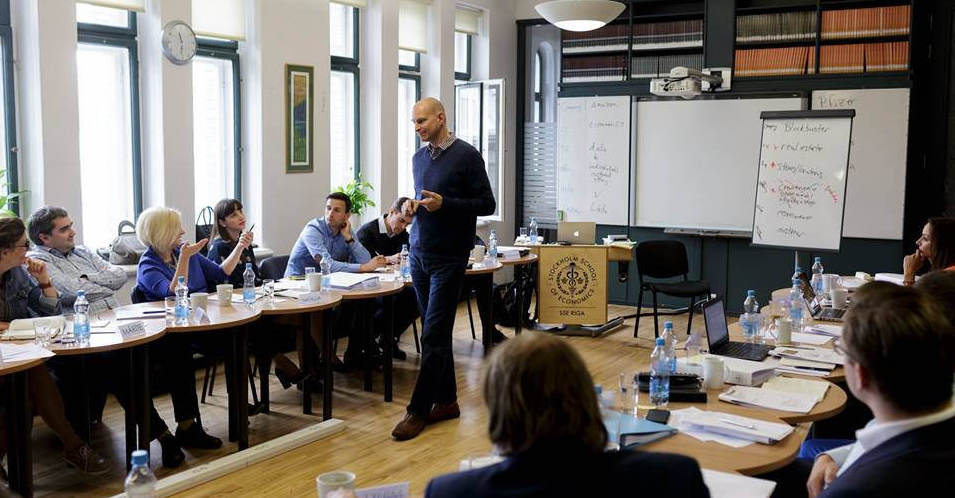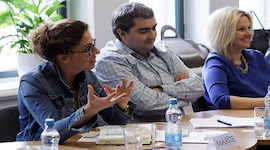WDI’s Performance Measurement and Improvement team, together with Good Business Lab, will conduct an ex-post evaluation of TechnoServe business accelerator programs that have operated in Chile, Peru, Guatemala, El Salvador, Honduras, Nicaragua and Panama since 2008. Using WhatsApp and phone interviews to collect data from program participants, we seek to estimate the sustainability of the programs’ impact on the entrepreneurs and their businesses.
 WDI’s executive education programs, delivered in partnership with the Stockholm School of Economics (SSE) in Riga, are attracting more international participants, bringing diverse opinions to the classroom and thereby adding value to the programs.
WDI’s executive education programs, delivered in partnership with the Stockholm School of Economics (SSE) in Riga, are attracting more international participants, bringing diverse opinions to the classroom and thereby adding value to the programs.
In past years, participants in the executive education offerings from WDI’s Education initiative at SSE Riga are citizens of host country Latvia and one or two neighboring Baltic countries. But for this year’s spring programs – the flagship, 10-day Strategic Management Program (SMP), Supply Chain and Logistics Management and Advanced Negotiations – drew participants not only from Latvia but also Russia, Chile, Estonia, Lithuania, Germany, Ukraine and even from as far away as Canada.
Santa Zeidaka, program manager at SSE Riga, said a key selling point is that its offerings are highly ranked in the Nordic and Baltic regions. She also said SSE Riga leverages its alumni network to spread the word on its programs and promotes them at conferences and on social media.
Zeidaka said a more international classroom benefits all the participants.
“Having an international group helps people open up more,” she said. “Participants get to see the problems from more diverse perspectives and this pushes participants to open their minds more, which is valuable when people work in international companies.”
For the popu lar SMP – also known as a “mini MBA” – participants came from Latvia, Lithuania, Ukraine and Canada. The program, tailored for high potential, mid- to senior-level managers, features four modules – strategy, finance, marketing, and leadership – and is structured around an integrative strategic framework. The program, held in May, combines lectures, discussions, cases and exercises. Participants also conduct group work, which enhances their critical thinking, decision-making and teamwork skills.
lar SMP – also known as a “mini MBA” – participants came from Latvia, Lithuania, Ukraine and Canada. The program, tailored for high potential, mid- to senior-level managers, features four modules – strategy, finance, marketing, and leadership – and is structured around an integrative strategic framework. The program, held in May, combines lectures, discussions, cases and exercises. Participants also conduct group work, which enhances their critical thinking, decision-making and teamwork skills.
Amy Gillett, vice president of WDI’s Education Initiative, said the fact that the SMP drew participants from four countries speaks to its strong reputation. She said participants around the world are recognizing the great value of this program.
“The Strategic Management Program is greatly enriched by having such a global audience,” she said. “Since the program is highly interactive with participants sharing their experiences, these diverse viewpoints spark new ideas and connections. Next year, we expect to attract participants from even more countries.”
WDI Senior Research Fellow and Healthcare Initiative consultant Prashant Yadav was a featured speaker at a supply chain conference July 23 in Chile.

Yadav spoke about successful supply chains that serve customers at the base of the pyramid (BoP) at the 2015 Logistics and Supply Chain Conference in Santiago. He touched on the main challenges in designing supply chains to facilitate the introduction of new products in BoP markets, how to implement and operate supply chains that reach the BoP, and solid examples of public and private entities that reached new market segments.
Yadav was joined at the one-day conference by fellow speakers Hau L. Lee, the Thoma Professor of Operations, Information and Technology at the Stanford Graduate School of Business, and David Simchi-Levi, a professor in the Department of Civil and Environmental Engineering at MIT.
The conference was organized by Seminarium, a leader in executive development in Latin America and a longtime WDI partner for executive education programs in that region.